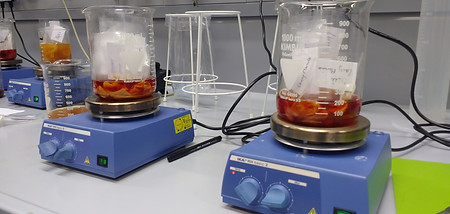Digital
CDHD - Communication and learning Helper for Deaf and Hearing people
Application for Hololens to aid Deaf people in learning and in communicating with hearing people.
Project developed during the Usability Engineering Masters course together with Pimchanok Sripraphan and Vivien Nwoye (2017).
Participated of the Accessathon - Hackathon for disabilities in Rhein-Waal University.
Digital
CDHD - Communication and learning Helper for Deaf and Hearing people
Application for Hololens to aid Deaf people in learning and in communicating with hearing people.
Project developed during the Usability Engineering Masters course together with Pimchanok Sripraphan and Vivien Nwoye (2017).
Participated of the Accessathon - Hackathon for disabilities in Rhein-Waal University.
Fabricademy 2017
week 2 - Bio Dyes and Biofabrics

Exploration of dying fibers (animal and vegetable) with color from natural resources such as fruits, vegetables and beans. Exploration of creating biomaterials.
Assigment
Work in groups and explore:
- One natural or bacterial dye
- Crafted or grown material
Biodying of fibers
The students from FabLab worked together in the laboratory from Rhein-waal university. First as a group we separated equal amounts of many different animal and vegetable fibers. Then each of us chose one animal and one vegetable fiber and separated, weighted and labled 8 samples of each with plastic tabs. I chose as the animal fiber a 80% alpaca, 14% wool and 6%poliamide. As vegetable fiber I chose a 100% linen.
We washed all the fibers with water and soap. The vegetable fibers we also boiled in 4 liters of water with 2 tablespoons of baking soda.
Meanwhile, each of us chose a different ingredient as natural dye to work with. I worked together with Wei Cheung using the golden onion skins. To get the color, we weighted 1/4 of the weight of the fibers of skins and boiled them for about 30 min. After that we strained it to keep only the liquid.
For the experiment, we separated half the fibers to apply mordant and the other half would be dyed without mordant to analyse the differences of the colors. The fibers that would have mordent applied, were left one hour in hot water mixed tartaric acid, according to the weight of the fibers.
Starting with the fibers that would not have mordent applied, we boiled separately the animal and vegetable fibers for 30 min in a part of the onion skin solution because the animal fibers need to be boiled in lower temperature than the vegetable fibers. After the fibers with mordant were ready they were also boiled for the same amount of time. We left all fibers resting in the color solution for one day.
Next, we proceeded to experimenting with modifiers, which I worked together with Arsiema and Wei in our house. We used vinegar, copper and alum as modifiers. Again, we boiled separately the animal and vegetable fibers in the onion solution, for they need different temperatures.
Vinegar: 21g of vinegar in 180g of water. Fibers boiled for 10 min.
Copper: 20g of copper in 200g of water. Fibers boiled for 20 min.
Alum: 8g of alum in 180g of water. Fibers boiled for 10 min.
We left the fibers to rest in the solution overnight and put them to dry during the next day.

fig 2.8 - Final results labeled.

fig 2.1 - Preparing the fibers samples: separating, weighting and labeling.

fig 2.2 - Boiling onion skins.

fig 2.3 - Final onion color solution.

fig 2.4 - Boiling fibers in color solution.

fig 2.5 - Vegetables fibers boiling in copper solution.

fig 2.6 - Fibers resting in modifiers solution.

fig 2.7 - Final results drying.
Biopolymers
In this assigment, I worked together with Gerantina and Wei to modify the following starch plastic recipe:
1. Mix 3g of baking powder with 22g of water. Reserve.
2. Mix 75g of water with, 8g of starch, 15g of vinegar, 22g of glycerine.
3. Heat it and stir until it thickens.
4. Add the baking powder and water solution.
5. Stir and boild until it is gooey. (5 to 10 min).
6. Let it dry for 1 - 2 days.
For this recipe we used the tapioca as starch. We first did the original recipe to have comparison. Then as first modification we switched the vinegar for 70g of kurkuma powder (fig 2.11). As second modification we switched the tapioca for corn starch and as third modification we switched the vinegar for lemon juice and added minced straberries to add color. Then we decorated them with a thread and a leaf. (fig 2.12)
Unfortunately all these experiments did not dry after two weeks and also got molded, which was very disappointing.

fig 2.9 - Weighting glycerin for the recipes.

fig 2.11 - On the left the starch with kurkuma and the original recipe on the right.

fig 2.10 - Third modification. Adding lime juice and strawberries.
